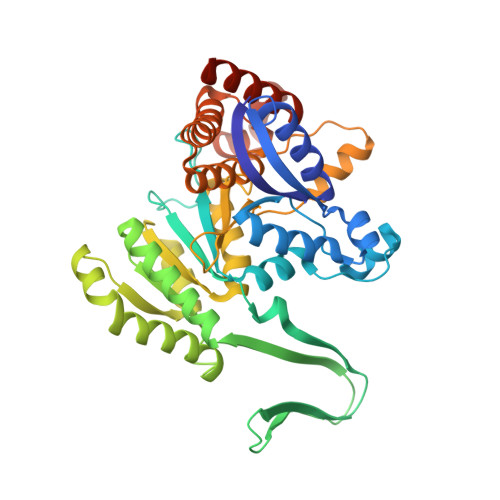Cancer-associated IDH1 mutations produce 2-hydroxyglutarate.
Dang, L., White, D.W., Gross, S., Bennett, B.D., Bittinger, M.A., Driggers, E.M., Fantin, V.R., Jang, H.G., Jin, S., Keenan, M.C., Marks, K.M., Prins, R.M., Ward, P.S., Yen, K.E., Liau, L.M., Rabinowitz, J.D., Cantley, L.C., Thompson, C.B., Vander Heiden, M.G., Su, S.M.(2009) Nature 462: 739-744
- PubMed: 19935646
- DOI: https://doi.org/10.1038/nature08617
- Primary Citation of Related Structures:
3INM - PubMed Abstract:
Mutations in the enzyme cytosolic isocitrate dehydrogenase 1 (IDH1) are a common feature of a major subset of primary human brain cancers. These mutations occur at a single amino acid residue of the IDH1 active site, resulting in loss of the enzyme's ability to catalyse conversion of isocitrate to alpha-ketoglutarate. However, only a single copy of the gene is mutated in tumours, raising the possibility that the mutations do not result in a simple loss of function. Here we show that cancer-associated IDH1 mutations result in a new ability of the enzyme to catalyse the NADPH-dependent reduction of alpha-ketoglutarate to R(-)-2-hydroxyglutarate (2HG). Structural studies demonstrate that when arginine 132 is mutated to histidine, residues in the active site are shifted to produce structural changes consistent with reduced oxidative decarboxylation of isocitrate and acquisition of the ability to convert alpha-ketoglutarate to 2HG. Excess accumulation of 2HG has been shown to lead to an elevated risk of malignant brain tumours in patients with inborn errors of 2HG metabolism. Similarly, in human malignant gliomas harbouring IDH1 mutations, we find markedly elevated levels of 2HG. These data demonstrate that the IDH1 mutations result in production of the onco-metabolite 2HG, and indicate that the excess 2HG which accumulates in vivo contributes to the formation and malignant progression of gliomas.
Organizational Affiliation:
Agios Pharmaceuticals, Cambridge, Massachusetts 02139, USA.



















